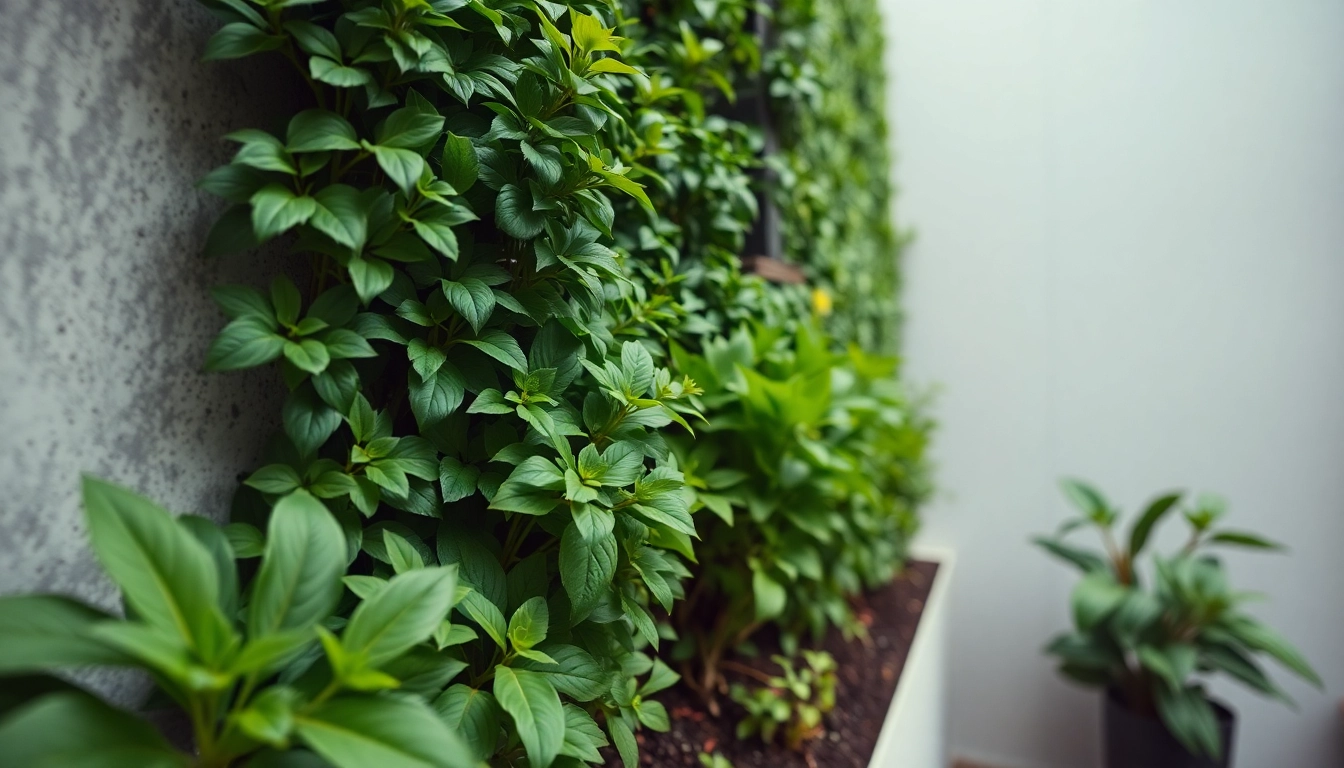Understanding Vertikale Gärten: A Beginner’s Guide
Definition and Benefits of Vertikale Gärten
Vertikale Gärten, or vertical gardens, are an innovative solution to urban gardening that allows for the cultivation of plants in a vertical manner, utilizing wall space and other structures. This gardening style not only beautifies urban environments but also helps in improving air quality, conserving space, and promoting biodiversity in crowded city landscapes. The benefits are considerable: they can enhance insulation in buildings, reduce energy costs, and create inviting green spaces that contribute to mental well-being. By integrating vertikale Gärten into our living spaces, we can foster healthier lifestyles while reaping the aesthetic rewards of greenery.
Common Plant Choices for Vertical Gardens
When selecting plants for your vertical garden, it’s essential to consider species that thrive in vertical setups. Some popular options include:
- Herbs: Basil, mint, and rosemary are excellent choices, providing easy access for culinary uses.
- Succulents: Varieties such as echeveria and jade plants not only require minimal water but also offer stunning visual appeal.
- Ferns: Boston ferns and maidenhair ferns add lush greenery and thrive in vertical arrangements.
- Flowering Plants: Consider trailing plants like vinca and nasturtium, which provide beautiful blooms.
- Vegetables: Climbing varieties such as peas and beans can also be integrated into vertical systems for functional gardening.
Essential Components of a Successful Vertical Garden
A successful vertical garden relies on several essential components:
- Structure: A sturdy framework is vital. Options can include wall planters, panels, or trellises.
- Soil: You’ll need a lightweight, well-draining soil mix designed for vertical gardening.
- Irrigation System: Efficient watering techniques such as drip irrigation or self-watering systems are crucial to maintain consistent moisture without overwatering.
- Light Conditions: Ensure that your vertical garden is located in a spot with adequate light depending on the plant species selected.
Planning Your Vertikale Gärten Installation
Choosing the Right Location and Conditions
The success of your vertical garden begins with the right location. Assess your available space, keeping in mind factors like sunlight exposure, wind conditions, and accessibility for maintenance. Ideally, choose an area that receives at least 6 hours of daylight, combined with sheltered spots to protect delicate plants from strong winds. South-facing walls typically offer optimal conditions for growth, but creative solutions such as utilizing north-facing walls with shade-loving plants can yield beautiful results as well.
Design Considerations: Layout and Aesthetics
Designing a vertical garden involves thoughtful aesthetics as well as functionality. Consider the following:
- Color Schemes: Select plants that complement each other and suit your overall décor style.
- Plant Heights: Layer taller plants at the back, with shorter varieties in front to enhance visibility.
- Textures: Incorporate a mix of leaf shapes and sizes to create an attractive visual contrast.
- Patterns: Employ symmetry or geometric patterns for modern designs, or a more organic arrangement for a natural feel.
Creating a Maintenance Schedule for Your Garden
Establishing a comprehensive maintenance schedule is crucial for the vibrancy of your vertical garden. Regular tasks should include:
- Watering: Depending on the plants selected, watering needs may vary; find a balance that keeps the soil consistently moist.
- Fertilizing: Use organic fertilizers on a bi-weekly basis during the growing season to support lush growth.
- Pruning: Regularly trim back overgrown plants to maintain shape and encourage healthy growth.
Installation Techniques for Vertikale Gärten
Step-by-Step Guide to Vertical Garden Setup
Setting up your vertical garden can be accomplished through the following key steps:
- Site Preparation: Clear the installation area of any debris; check for watering access and sunlight exposure.
- Framework Assembly: Depending on your chosen structure, assemble wall planters, grids, or lattice frameworks securely.
- Soil Filling: Prepare your vertical garden with a suitable soil mix, filling planters or growing pockets adequately.
- Planting: Begin with the tallest plants at the background or top. Plant according to the layout designed, adding texture and variety.
- Irrigation Setup: Connect any required irrigation systems, ensuring adequate coverage of all plants.
- Final Checks: Inspect for any adjustments, ensuring the entire system is securely in place and ready for watering.
Employing Various Hydroponic Systems
Hydroponic systems can be an efficient and productive way to establish a vertical garden. Techniques include:
- Wicking Systems: These systems use capillary action to draw water up to plant roots.
- Nutrient Film Technique (NFT): A thin film of nutrient-rich water continuously flows over the roots, providing adequate nutrients while conserving water.
- Deep Water Culture (DWC): Plants are suspended in a nutrient solution, with their roots submerged, creating strong growth.
Choosing the right hydroponic system will greatly influence your vertical garden’s success and efficiency.
Incorporating Drip Irrigation for Efficiency
Drip irrigation is an excellent way to ensure your vertical garden receives consistent moisture without over-saturating the plants. The benefits include:
- Water Conservation: Directly delivering water to the roots minimizes waste.
- Even Water Distribution: Provides uniform moisture levels across various plants.
- Reduced Pesticide Usage: By limiting moisture on foliage, you can lower the likelihood of fungal diseases.
Maintenance Tips for Thriving Vertikale Gärten
Pruning and Plant Care Essentials
Consistent pruning and plant care are necessary to maintain a vibrant vertical garden. Adhere to these best practices:
- Regular Checks: Inspect plants weekly for signs of stress or disease.
- Trim Dead or Damaged Leaves: Prompt action on wilted leaves will enhance overall plant health.
- Encourage Healthy Growth: Pinch off flowers of herbs until they’re established to promote foliage growth instead of flowering.
Identifying and Managing Diseases and Pests
While vertical gardens can be resilient, they can still suffer pests and diseases. Strategies include:
- Regular Inspections: Routinely check for common pests like aphids and spider mites.
- Companion Planting: Use plants that naturally deter pests, thus maintaining your garden ecosystem.
- Organic Remedies: Implement neem oil or insecticidal soap for chemical-free pest management.
Seasonal Adjustments for Optimal Growth
Revising your vertical garden based on seasonal changes is crucial:
- Winter Preparations: Certain plants may require protection or retraction indoors during colder months.
- Summer Care: Higher temperatures may necessitate more frequent watering to combat evaporation.
Showcasing Your Vertikale Gärten: Case Studies and Examples
Inspirational Vertical Garden Projects Around the World
Great examples of successful vertical gardens have emerged worldwide, showcasing creativity and sustainability. Notable mentions include:
- The Green Wall at the Musée du quai Branly in Paris: A stunning vertical installation that covers 840 square meters.
- Urban Garden at the Changi Airport in Singapore: This garden features diverse plant selections that enhance the airport’s aesthetic ambiance.
- The Bosco Verticale in Milan: A residential project that consists of two residential towers beautifully adorned with plants.
Types of Vertical Gardens: Indoor vs. Outdoor
Choosing between indoor and outdoor vertical gardens primarily depends on space availability and environmental conditions. Indoor vertical gardens often consist of lighter plants suited for lower light levels such as ferns and pothos. Outdoor gardens may include a broader range of plants, from colorful flowers to edible options. Each type provides distinct benefits and should be tailored according to design goals.
Measuring Success: Growth Metrics and Aesthetic Appeal
Monitoring the success of your vertical garden can be evaluated using various metrics:
- Plant Health: Monitor the health and growth rates of plant species used.
- Aesthetic Appeal: Consider how well the garden integrates with its environment and enhances the overall aesthetics of the space.
- Diversity: Aim for biodiversity to foster a resilient ecosystem within your vertical garden.
These metrics not only contribute to the overall success but also encourage continual improvement and innovation in vertical gardening practices.



